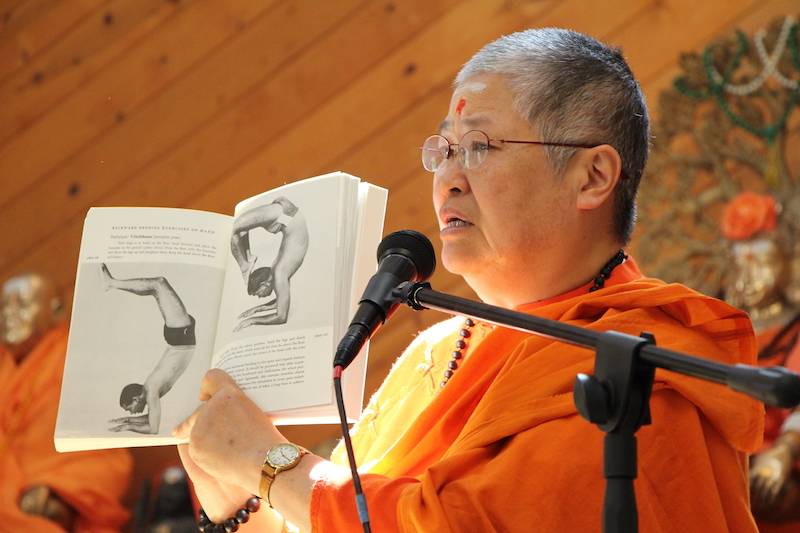Yogic Guidelines for Good Conduct
by Swami Sitaramananda
When we drive in the traffic, we expect everyone to follow the rules of traffic, driving on the proper side of the road and observing traffic signals. We would not think, “I am the special one that doesn’t have to follow rules, only others have to, not me.”
Separation causes suffering
Why then, do people so often disobey basic guidelines of good conduct? Our breaking of ethical laws and failure to follow guidelines of conduct comes from our idea that we are unique, and therefore free to do what we want.
This comes from not seeing the big picture of our identity and inter-relatedness to others. Although we are indeed unique in our self-expression and the lessons we will learn in this life, we all fundamentally share the same evolutionary journey.
The bottom line is that we are one Universal Spirit in myriad expressions. When we fail to understand and live by the truth of this “Unity in Diversity,” we continue treating our brothers and sisters as separate and inferior–or as superior–to us, and from that, many problems in human relationships ensue. You can read more about Making the World a Better Place with Yoga.
Teachings of Patanjali Maharishi
Thankfully, when these problems overwhelm us, the teachings of yoga are available for us to draw from and look to for guidance. Centuries ago, Patanjali Maharishi compiled the Raja Yoga Sutras and presented to the world the summary of the yogic guidelines of conduct that can help people to straighten out their minds and free themselves–instead of becoming more entangled by the bonds of karmas. For more on this you can read this article Understanding Karma with Swami Vishnudevananda.
What is the meaning of “straighten out the mind?” It means that the mind has its own favorite ways to distort our perceptions, its own repeated habits of thinking and reacting to situations–and this leads to the repetition of the same mistakes in seeing oneself and others.
Following these guidelines laid out by Patanjali will help us to correct our thinking, become more clear in our perceptions, and bring us closer to self realization. These are guidelines that if followed will improve our lives in the long term and help remove obstacles stemming from our karmic tendencies, character defects, and bad habits.
Yamas: Restraints (The Things Not To Do)
- – Ahimsa: Ahimsa means non-violence in thought, word and deed. It means restraining oneself from the tendency to be angry when one’s desires are not met, or the tendency to abuse others and enter into conflicts or wars.
- – Satya: Satya means truthfulness–refraining from the tendency to exaggerate, to manipulate others, or to tell lies in order to achieve an egoistic goal. Sincerity, honesty and straightforwardness will help to simplify and clear the mind, thus achieving inner peace.
- – Brahmacharya: Brahmacharya is control of the sensual and sexual drive. Through practicing brahmacharya, we can restrain the tendency to seek sensual pleasures as the goal of life, and to waste our sexual energy–which can be converted into spiritual energy. This guideline advises us to avoid sexual misconduct and to regulate our impulses, question our motives, and help reduce the dramas in human interactions that tend to arise from uncontrolled sexual energy.
- – Asteya: Asteya means non-stealing. Observing this guideline will counteract our tendency to give in to our desires, or think that satisfying material desires is the goal of life. It will help us to be content, knowing that what is supposed to come to us by our own karmas and merits will come naturally, without our manipulation or intervention.
- – Aparigraha: Aparigraha means non-accumulation or non-acceptance of bribes. Observing this guideline counteracts our tendency to think that the more we attain or possess, the more we will be safe and secure. It further guides us not to forfeit our soul to the material life, and to cultivate an attitude of detachment towards material possessions. Leading a simple life allows the spirit to remain light and detached.
In order to practice these you can read about How to Avoid Unhealthy Habits.
Niyamas: Observances (The Things To Observe Or To Do)
- – Saucha: Saucha is purity. This observance will help us counteract impurities in our bodies, minds, and outer environments, and help us come into deeper contact with our true selves. By purifying the emotions and thoughts, which are like coverings over our eyes, we can begin to see more clearly and gain a more true perspective.
- – Santosha: Santosha is contentment. This practice will help us counteract the tendency to look externally for happiness and become dissatisfied with our lots in life, rather than counting our blessings. Through practicing Santosha, we begin to realize that God’s grace is always with us.
- – Tapas: Tapas means austerity. This practice will help us to counteract the belief that comforts of the body and mind are the goals of life. It will help us avoid imprisonment in the sensual, limited life that is governed by the mind and the senses. Tapas will help us to assert our supremacy over the mind and emotions, freeing us and give the power back to the spirit.
- – Swadhyaya: Swadhyaya is the study of scriptures. Doing this will help us to counteract the idea that only what we can see and what people tell us about ourselves is true. The scriptures, on the contrary, tell us of a reality beyond the normal perceptions and glorify the true Self; they will inspire us in our search for Truth .
- – Ishwarapranidhana: Ishwarapranidhana means self-surrender–to God or a higher power. This will counteract our tendency to think that we are the best and the top, that we have all the powers and that we are controlling our lives. With this egoistic bend of our mind, we do not have to adjust or accept something that is not to our liking, so we blame and resent instead of trying to see the big picture. Practicing self-surrender will help us work through our karmas by practicing acceptance and knowing that everything happens for a reason.
For more information this article talks about how Concentration and Commitment leads to Freedom.
© Swami Sitaramananda 2018 No part of this article may be reproduced in any form without the written permission of the author.
Yoga Teacher Training Course
Check out our 200-hour Yoga Alliance certified Yoga Teacher Training Courses offered twice a year in California, 3x in Vietnam, once in China and once in Japan.
Foundational Courses
Choose from upcoming courses for beginners and intermediate level students.
Yoga Vacation
Rejuvinate your body and mind. Experience and progress with daily Yoga classes. Learn the 12 basic asanas and pranayama. Enjoy daily meditation, chanting, and organic vegetarian meals.
Rejuvenate Your Being
A Yoga vacation is an ideal getaway to change perspective towards one’s life and become healthier, more relaxed and connected.
Follow us
[et_social_follow icon_style=”slide” icon_shape=”rounded” icons_location=”top” col_number=”2″ counts=”true” counts_num=”0″ outer_color=”dark”]



0 Comments
Trackbacks/Pingbacks